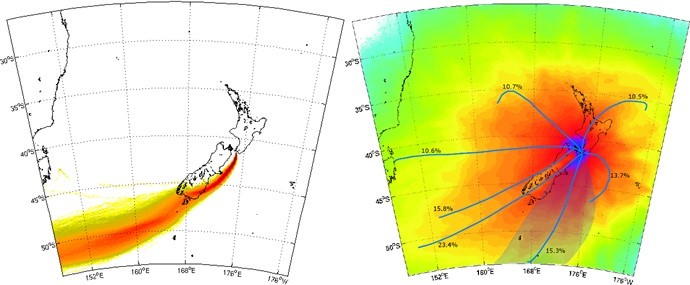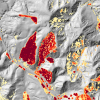Native forests absorbing more carbon dioxide
New research led by NIWA atmospheric scientists Drs Kay Steinkamp and Sara Mikaloff-Fletcher indicates that New Zealand’s native forests absorb up to 60% more carbon dioxide than previously thought. This result is surprising, the researchers say, because of where and how this is happening.
“Carbon uptake this strong is usually associated with peak growth of recently planted forests and tends to slow as forests mature,” says Mikaloff-Fletcher. “This amount of uptake from relatively undisturbed forest land is remarkable and may be caused by processes unique to New Zealand or part of a wider global story."
Indigenous forests cover about 6.2 million hectares in New Zealand. Carbon dioxide is a primary greenhouse gas and responsible for most of the human-induced warming in the atmosphere. Globally, carbon sinks, such as oceans and forests, have helped mitigate the effects of climate change by absorbing about half the carbon dioxide emitted by human activities over the past few decades. New Zealand’s forest carbon uptake played a key role in meeting our commitments under the Kyoto Climate treaty and is expected to play an important role in meeting our COP21 commitments.
Mikaloff-Fletcher and her team used NeSI supercomputers and an “inverse” modelling approach to estimate the amount of carbon uptake. This technique infers carbon uptake from measurements of the amount of carbon dioxide present in the atmosphere at a network of sites in New Zealand and on board carbon ships that routinely travel between New Zealand and Japan. In order to connect observed changes in the atmosphere with carbon uptake, we need detailed information about what parts of New Zealand the air has passed over before reaching the site. The team used a high resolution weather forecast model run on NIWA’s Fitzroy supercomputer to simulate the winds over a region. Simulations from a land model, run by partners at GNS Science, and ocean carbon data provided additional information.
From there, the team calculated the best combinations of sources and sinks to match the data. They found that much of the carbon dioxide uptake was occurring in native forests in the southwest of the South Island.
“NeSI supported this work from the initial project development stage through to new work we are planning for the coming year,” says Mikaloff-Fletcher. “New Zealand’s topography has a major impact on the airflows over our region, so high resolution modelling is essential to be able to use this technique effectively in New Zealand. However, the higher the resolution of the model, the more computationally expensive it is. NeSI support opened the door for us to work with models running at the spatial resolution we need.”
This project included data from NIWA’s clean air station at Baring Head near Wellington, its atmospheric research station at Lauder in Central Otago, and measurements taken from a ship that collects observations on a line between Nelson and Osaka, Japan.
“The inverse approach integrates information about carbon dioxide sources and sinks from atmospheric data, ocean data and models,” says Steinkamp. “The story the atmosphere is telling us is that there’s a big carbon sink somewhere in the South Island, and the areas that seem to be responsible are those largely dominated by indigenous forests. However, we cannot rule out an important role for carbon uptake in the hill country or from pasture from our current data.”
The National Inventory method is the basis for the Ministry for the Environment's annual reporting on New Zealand’s carbon uptake. This internationally standardised methodology puts the amount of carbon being absorbed by all New Zealand forests at 82 teragrams CO2 (a teragram is one million metric tons) total over 2011-2013, the period studied by Mikaloff-Fletcher’s team. Once accounting rule differences are corrected for, the new NIWA measurement approach finds that actual carbon uptake could be up to 60% higher.
The inventory-based method estimates carbon uptake using measurements of tree growth taken from about 100 sampling areas, and extrapolates this to the entire country using statistical techniques and modelling. There is still considerable work to be done in comparing the two independent approaches.
“We need to find out definitively what processes are controlling this unexpectedly large carbon uptake, in order to understand the implications for land management and climate treaties,” says Mikaloff-Fletcher. “We need additional measurements to tell us if this is unique to the southern half of the South Island or holds across a wider range of New Zealand.”
Next steps include incorporating data from NIWA’s newest atmospheric CO2 observing site, Maunga Kākaramea/Rainbow Mountain in the central North Island, deploying two new atmospheric CO2 observing sites and a major improvement to model resolution. This will start to shed light on what’s happening in the North Island and the Canterbury plains.
The results of the research have been published in the scientific journal Atmospheric Chemistry and Physics.








